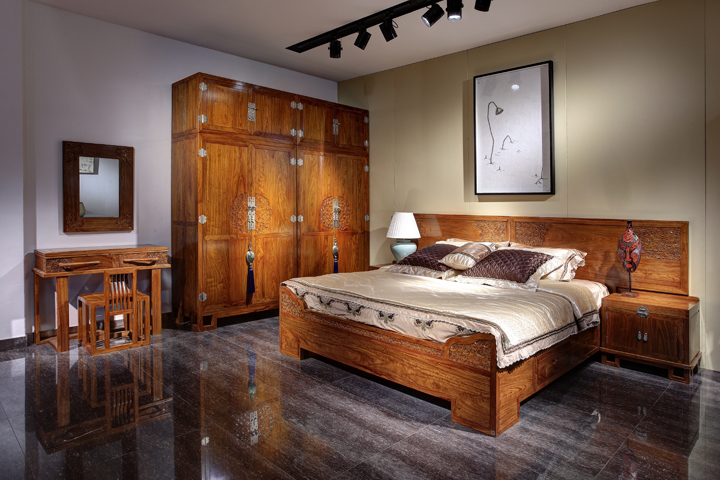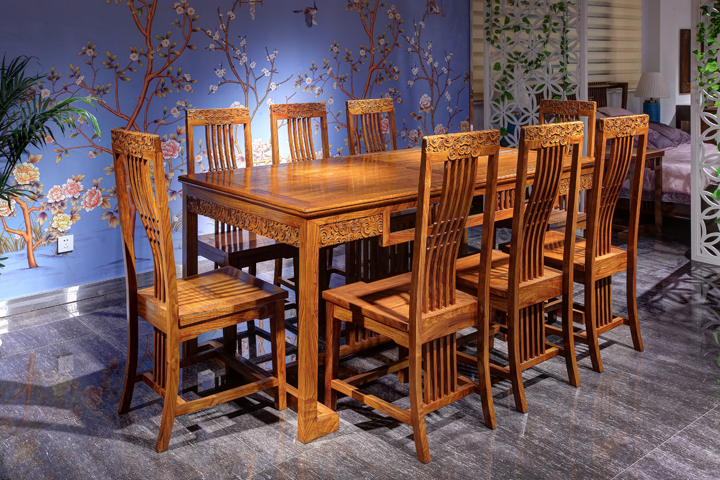
In recent years, the furniture industry has seen a new form of furniture called "new Chinese style". In this year's Dongguan Famous Furniture Exhibition and Shenzhen Furniture Exhibition, the new Chinese furniture is hot, and the market is experiencing an explosive trend. For classical furniture companies, how to deal with opportunities and challenges during the period of industrial transformation? How to adjust their business strategies according to the market?
The author believes that the "new Chinese style" is not a rigid combination of ancient cultural symbols, but a product of the perfect combination of classical and modern with the following characteristics: In the future, Chinese furniture will gradually turn to the emphasis on introverted and elegant beauty represented by Ming style furniture. The Chinese aesthetic value; it will be more concise and modern, while at the same time taking into account the consumer's pursuit of introverted luxury and atmosphere. With the return of Chinese lifestyle and Chinese aesthetics, the modern modern Chinese aesthetics represented by the Song Dynasty aesthetics and represented by Ming style furniture may have a new whirlwind in the world and create a new trend of home aesthetics. In turn, it creates an invaluable market value.
How do "new Chinese" furniture rush to the market? "New Chinese" furniture how to grab the market. Pure classical furniture encounters the cold winter. In the field of classical furniture, there are two different styles of Ming furniture and Qing style furniture. Classical furniture companies, some are based on the Qing style, some are the Ming style as the selling point, more are the two styles to eat, what someone wants to produce. In actual sales, there are markets for both Ming-style furniture and Qing style, which can be said to be equally divided.
As the pinnacle of Chinese classical furniture, Ming style furniture has been unanimously recognized by classical furniture connoisseurs, collectors and scholars, and has eternal market value. Compared with Qing style furniture, Ming style furniture emphasizes the beauty of restraint, and does not take publicity and luxury as its core value. The Ming-style models that have been handed down are relatively slender and elegant, and they show their intrinsic noble temperament, which is extremely durable and durable. Unfortunately, most consumers do not have the ability to appreciate the beauty of Ming furniture. Neglected by the Tibetan and academic circles, the Qing style furniture, characterized by large and heavy carvings, was once popular in actual sales. In addition to the aesthetic ability of consumers, Qing style furniture is more able to meet the psychological needs of consumers for greater greed because of its large size.
However, whether it is Ming furniture or Qing style furniture, since 2014, it has suffered a cold market. At the above-mentioned two major Guangdong furniture fairs, pure classical furniture enterprises and enterprises with "new Chinese style" orientation have received almost the same level of ice and fire. The former booths are often left out and lack of interest. The latter The booths are very lively, and the sales staff of some companies are almost overwhelmed.
"New Chinese" furniture business classification is clear

“New Chinese†furniture has evolved from tradition. Due to the influence of the above two classical furniture styles, it is naturally divided into two main categories:
One is the "Xinming style" furniture featuring Ming style furniture, which is elegant and simple. More representative brands include U+, all things (new brand of Beijing Qumei), Pingyi, how much, up and down, Qiankun (new brand under the furniture), Foshan reading pear, Shenzhen free workshop. These brands have the following characteristics: do not take material first, pay attention to the intrinsic. Some of these brands are made of walnut, and some are mainly Hedgehog rosewood; all the furniture of all things are even made of bamboo laminated timber, U+ uses a variety of wood, including purple sandalwood, maple, ash. Although the above-mentioned brands are basically not based on mahogany, especially in the wood grade (except for the "up and down" brand), but because the designer's understanding of the meaning of Chinese beauty is relatively in place, the overall taste is not affected by the material.

These "new Ming" furniture sometimes do not use traditional Chinese furniture symbols, such as the most common vertical narrow plates, slabs, and carved Chinese chairs. Although these brands do not aim at large-scale operations, most of them are developing rapidly, and the products are even in short supply.
Another type of furniture can not be called "new clear style", but the perception of the people has the characteristics of thick and large-scale furniture, and the products are often used in large quantities. Most of the companies in this style have been transformed from traditional mahogany furniture companies and are very sensitive to sales. The author has called his product style "realistic new Chinese style". The “realistic new Chinese†enterprise has not strictly established its own aesthetic orientation, but also uses market research feedback as the guiding ideology. Since most consumers in China are paying more attention to the feeling of “higherâ€, they lack sufficient understanding of aesthetics and such products can meet their needs. Most of the “realistic new Chinese†products that have emerged are low-priced mahogany such as hedgehog and red sandalwood. The price difference varies greatly depending on the success of the brand operation.
It is worth mentioning that most of the “realistic new Chinese†companies have not established their own design teams to solve the problems of new product development. Instead, they have cooperated with professional furniture design companies to quickly introduce new styles, which greatly saves money. Time has increased the speed of new product output. However, because the enterprise itself does not form a complete concept of aesthetic standards, it is only based on market experience to find the direction, and the level of the design company is mixed. The products of this part of the enterprise cannot be compared with the "new Ming style" from an aesthetic point of view. However, the lack of aesthetics of consumers has enabled these enterprises to survive and develop.
Consumer trends affect furniture production

The design and production of furniture must first pay attention to the market demand. With the gradual improvement of living standards, in recent years, consumers who need to express their material strength with extravagance and publicity have become less and less. At present, the situation of urban residential decoration in China can best illustrate such a trend. In the case of model house decoration in domestic residential real estate, more than 80% of the proportions are based on simple European style and low-key luxury as the main tone of decoration. Most consumers also use this. The location of the renovated home. This can give us such clear information: the simple, introverted luxury represents the aesthetics of the mainstream crowd, which will be the consumption orientation for a long time.
However, although Chinese consumers have basically passed the stage of high-profile and wealth-rich, the pursuit of quality, atmosphere and restrained luxury will become a long-standing fact. From the perspective of residential decoration, Chinese consumers' pursuit of low-level luxury is still the mainstream of consumption. Therefore, we may wish to conclude that no matter how the style of the home (European, Chinese, mashup, etc.), the simple and restrained luxury is the mainstream value of China's home furnishing in the future. This can also be a good inspiration for companies in the mahogany furniture industry.
Another interesting phenomenon for furniture companies is the popularity of tea ceremony and tea clubs. With the improvement of domestic consumption levels and consumers' growing concern about healthy lifestyles, drinking tea has become a popular daily activity.
As early as in the Song Dynasty, the ancient literati and the literati used tea as a medium to explore thoughts, tasting art, and practicing spirit through tea in the form of elegant collections. It can be said that drinking tea and a series of cultural activities derived from it can even be called a part of Chinese culture. The popularity of the tea ceremony clearly shows that the Chinese lifestyle and Chinese aesthetic are returning. More importantly, today's scholars, both Chinese and foreign, reject the Qing style and respect the beauty of Ming style furniture. The new Chinese furniture featuring the "new Ming style" has been affirmed by people in the cultural and artistic circles. . The development of Chinese furniture in the future will be greatly influenced by the preferences of the cultural and artistic circles.
In addition, furniture companies should also pay attention to the needs of young consumers. The younger generation of Chinese consumers, represented by “post-70s†and “post-80sâ€, has become the mainstream of consumption in the domestic high-end market. Their consumption concept is completely different from that of the older generation of consumers who are keen on traditional mahogany furniture. Especially for the "post-80s" consumers, their feelings about beauty are much more delicate than the previous generation. They value the taste and intrinsic value of furnishings, advocating individualized values, and the consumer psychology is more sensible, impulsive and fashionable. In the face of traditional mahogany furniture, most of the “post-80s†consumers held a negative view and welcomed the improved mahogany furniture with a modern flavor. The elegant and simple modified classical furniture is not in contradiction with the modern furnishings. When properly matched, it can show the taste and personality.
Hair Thinning Scissors,Hairdressing Thinning Scissors,W-Teeth Hair Thinning Scissors,440C Stainless Steel Hair Scissors
Zhangjiagang Mister Tools Co., Ltd , https://www.msscissors.com
![<?echo $_SERVER['SERVER_NAME'];?>](/template/twentyseventeen/skin/images/header.jpg)